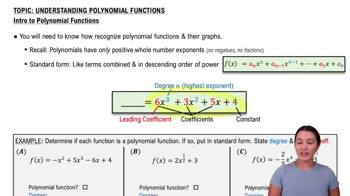Table of contents
- 0. Functions7h 52m
- Introduction to Functions16m
- Piecewise Functions10m
- Properties of Functions9m
- Common Functions1h 8m
- Transformations5m
- Combining Functions27m
- Exponent rules32m
- Exponential Functions28m
- Logarithmic Functions24m
- Properties of Logarithms34m
- Exponential & Logarithmic Equations35m
- Introduction to Trigonometric Functions38m
- Graphs of Trigonometric Functions44m
- Trigonometric Identities47m
- Inverse Trigonometric Functions48m
- 1. Limits and Continuity2h 2m
- 2. Intro to Derivatives1h 33m
- 3. Techniques of Differentiation3h 18m
- 4. Applications of Derivatives2h 38m
- 5. Graphical Applications of Derivatives6h 2m
- 6. Derivatives of Inverse, Exponential, & Logarithmic Functions2h 37m
- 7. Antiderivatives & Indefinite Integrals1h 26m
- 8. Definite Integrals4h 44m
- 9. Graphical Applications of Integrals2h 27m
- 10. Physics Applications of Integrals 2h 22m
4. Applications of Derivatives
Differentials
Problem 4.8.58a
Textbook Question
{Use of Tech} Fixed points of quadratics and quartics Let f(x) = ax(1 -x), where a is a real number and 0 ≤ a ≤ 1. Recall that the fixed point of a function is a value of x such that f(x) = x (Exercises 48–51).
a. Without using a calculator, find the values of a, with 0 ≤ a ≤ 4, such that f has a fixed point. Give the fixed point in terms of a.
 Verified step by step guidance
Verified step by step guidance1
Start by setting up the equation for a fixed point. A fixed point of the function f(x) = ax(1 - x) is a value of x such that f(x) = x. Therefore, set ax(1 - x) = x.
Rearrange the equation ax(1 - x) = x to form a quadratic equation. This can be done by expanding the left side to get ax - ax^2 = x, and then moving all terms to one side: ax - ax^2 - x = 0.
Factor the quadratic equation ax - ax^2 - x = 0. Start by factoring out x from the terms: x(a - ax - 1) = 0. This gives two potential solutions: x = 0 or a - ax - 1 = 0.
Solve the equation a - ax - 1 = 0 for x. Rearrange it to find x in terms of a: ax = a - 1, which simplifies to x = (a - 1)/a, provided a ≠ 0.
Determine the values of a for which the fixed points are valid. Since 0 ≤ a ≤ 4, check the conditions for x = 0 and x = (a - 1)/a to be valid fixed points. Note that x = 0 is always a fixed point, and x = (a - 1)/a is valid when a > 1.
 Verified video answer for a similar problem:
Verified video answer for a similar problem:This video solution was recommended by our tutors as helpful for the problem above
Video duration:
2mPlay a video:
Was this helpful?
Key Concepts
Here are the essential concepts you must grasp in order to answer the question correctly.
Fixed Points
A fixed point of a function f(x) is a value x such that f(x) = x. This means that when the function is applied to this value, it returns the same value. Finding fixed points often involves solving the equation f(x) - x = 0. In the context of the given function, identifying fixed points helps determine the values of a for which the function intersects the line y = x.
Recommended video:

Critical Points
Quadratic Functions
Quadratic functions are polynomial functions of degree two, typically expressed in the form f(x) = ax^2 + bx + c. In this case, the function f(x) = ax(1 - x) can be expanded to a quadratic form, which allows for the analysis of its properties, such as its vertex, axis of symmetry, and roots. Understanding the behavior of quadratics is essential for finding fixed points and analyzing their stability.
Recommended video:

Introduction to Polynomial Functions
Parameter Variation
Parameter variation involves changing the values of parameters in a function to observe how the function's behavior changes. In this problem, the parameter a affects the shape and position of the quadratic function f(x). By varying a within the specified range (0 ≤ a ≤ 4), we can determine how many fixed points exist and their corresponding values, which is crucial for solving the problem.
Recommended video:

Critical Points Example 2







